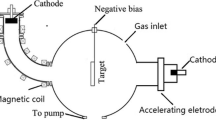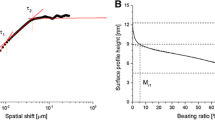Abstract
Copper-incorporated carbon films have been prepared on Si(100) and Corning (7059) glass substrates by the pulsed excimer laser deposition technique using KrF radiation (λ = 248 nm). Cold-pressed composite pellets, having compositions from 2 at. % to 11 at. % copper in carbon, were used as targets for ablation. Good quality, scratch-proof films were obtained at a laser energy density of 2–3 J/cm2 and a substrate temperature of 50 °C. The films were characterized by x-ray diffraction (XRD), Raman spectroscopy, x-ray photoelectron spectroscopy (XPS), UV-visible spectrometry, ellipsometry, and four-point probe resistivity measurements. Under similar deposition conditions, films obtained from composite targets of lower copper concentration are seen to have better diamond-like character as compared to those obtained from a pure graphite target. At such low concentrations, copper is seen to cluster in the form of nanoparticles. As the copper concentration increases in the films, they tend to acquire disordered graphitic network with degraded DLC characteristics, and the size of copper agglomerates increases from about 5 nm (for the 2 at. % case) to 85 nm (for the 11 at. % case). It is seen that an increase in the copper content leads to modifications in the carbon network, additional interband transitions, and reduction of the band gap.
Similar content being viewed by others
References
K. Kobayashi, N. Mutsukura, and Y. Machi, J. Appl. Phys. 59, 910 (1985).
A. Hiraki, T. Kawano, Y. Kawakami, M. Mayashi, and T. Miyasato, Solid State Commun. 50, 713 (1984).
D. B. Kerwin, I.L. Spain, R.S. Robinson, B. Dandin, M. Dubus, and J. Fontenille, Thin Solid Films 148, 311 (1987).
A. P. Malshe, S. M. Chaudhari, S. M. Kanetkar, S. B. Ogale, S. V. Rajarshi, and S. T. Kshirsagar, J. Mater. Res. 4, 1288 (1989).
I. Chen, J. Appl. Phys. 64, 3742 (1988).
H. Dimigen and H. Hubsch, Philips Techn. Rev. 41, 186 (1983/84).
H. Dimigen, H. Hubsch, and R. Memming, Appl. Phys. Lett. 50, 1056 (1987).
M. Wang, K. Schmidt, K. Reichelt, H. Dimigen, and H. Hübsch, J. Mater. Res. 7, 667 (1992).
P. A. Chen, Thin Solid Films 182, 261 (1989).
P. A. Chen, Thin Solid Films 204, 413 (1991).
H. Biederman, L. Martinu, and J. Zemek, Vacuum 35, 447 (1985).
S. A. Solin and A. K. Ramdas, Phys. Rev. B 1, 1687 (1970).
R. J. Nemanich and S. A. Solin, Phys. Rev. B 20, 392 (1979).
F. Tuinstra and J.L. Koening, J. Chem. Phys. 53, 1126 (1970).
R. Al Jishi and G. Dresselhaus, Phys. Rev. B 26, 4514 (1982).
P. Lespade, A. Marchand, M. Couzi, and F. Cruege, Carbon 22, 375 (1984).
M. Yoshikawa, G. Katagiri, H. Ishida, and A. Ishitani, Solid State Commun. 66, 1177 (1988).
M. Ramsteiner, J. Wagner, Ch. Wild, and P. Koidl, J. Appl. Phys. 62, 729 (1987).
E. H. Lee, D. M. Hembree, Jr., G. R. Rao, and L. K. Mansur, Phys. Rev. B 48, 15540 (1993).
N. H. Cho, K. M. Krishnan, D. K. Veirs, M. D. Rubin, C. B. Hopper, B. Bhushan, and D. B. Bogy, J. Mater. Res. 5, 2543 (1990).
R. J. Nemanich, J. T. Glass, G. Lucovsky, and R. E. Shroder, J. Vac. Sci. Technol. A 6, 1783 (1988).
N. Wada and S. A. Soli, Physica 105B, 353 (1981).
R. E. Shroder, R. J. Nemanich, and J. T. Glass, Phys. Rev. B 41, 3738 (1990).
B. D Cullity, Elements of X-ray Diffraction (Addison-Wesley, Reading, MA, 1978), pp. 284, 286.
G. Burkhard, H. Tamura, Y. Tanabe, A. Sawaoka, K. Uematsu, and S. Ohmura, J. Mater. Sci. Lett. 13, 1281 (1994).
C. D. Wagner, W. M. Rigs, L. E. Devis, J. F. Moulder, and G. E. Muilenberg, Handbook of X-ray Photoelectron Spectroscopy (Perkin-Elmer, Eden Prairie, MN, 1979).
N. J. Shevchik, Phys. Rev. Lett. 42, 846 (1974).
H. Tsai and D. B. Bogy, J. Vac. Sci. Technol A 5, 3287 (1987).
E. T. Arakawa, M. W. Williams, and T. Inagaki, J. Appl. Phys. 48, 3176 (1977).
J. P. Borgogno, B. Lazarides, and E. Pelletier, Appl. Opt. 21, 4020 (1982).
F. W. Smith, J. Appl. Phys. 55, 764 (1984).
B. E. Sernelius, K. F. Berggren, Z. C. Jin, I. Hamberg, and C. G. Granqvist, Phys. Rev. B 37, 10244 (1991).
S. A. Alterovitz, J. D. Warner, D. C. Liu, and J. J. Pouch, J. Electrochem. Soc.: Solid State Sci. Technol. 133, 2339 (1986).
M. Morgan, Thin Solid Films 7, 313 (1971).
Author information
Authors and Affiliations
Rights and permissions
About this article
Cite this article
Dikshit, S.J., Lele, P., Ogale, S.B. et al. Influence of in-process copper incorporation on the quality of diamond-like carbon films deposited by pulsed laser deposition technique. Journal of Materials Research 11, 2236–2241 (1996). https://doi.org/10.1557/JMR.1996.0284
Received:
Accepted:
Published:
Issue Date:
DOI: https://doi.org/10.1557/JMR.1996.0284




